A First-Timer’s Tour of South Korea
Our writer uncovers the beauty and history of two of South Korea’s most popular cities: Busan and Seoul
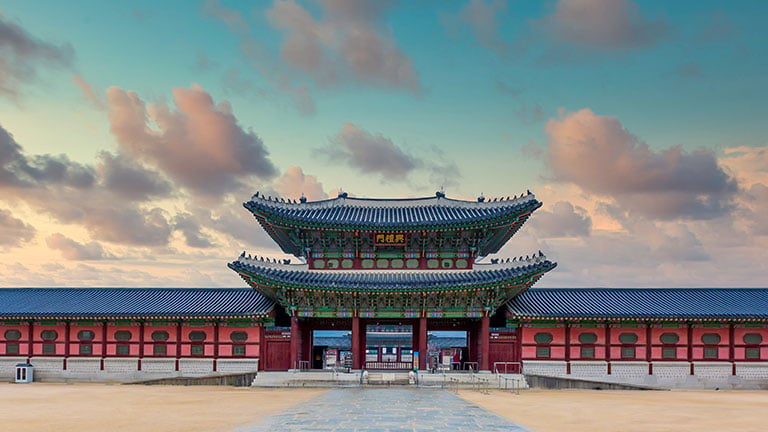
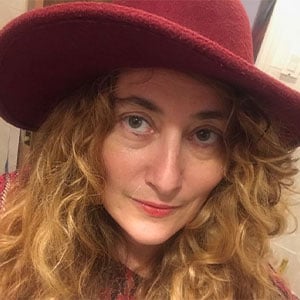
A smiling Korean woman plops a dollop of multicolored batter on a sizzling pan, where it quickly transforms into a crispy pancake. She cuts the golden-brown circle in two, places the half-moon pieces into espresso-size paper cups, and hands them to my husband, Dennis, and me. “That’s a mung bean pancake—a staple,” says our guide Michelle Hong, who is leading our small group on a food tour of the more than century-old Gwangjang Market in Seoul, the capital of South Korea. “It’s made with mung beans, rice, minced pork and kimchi.”
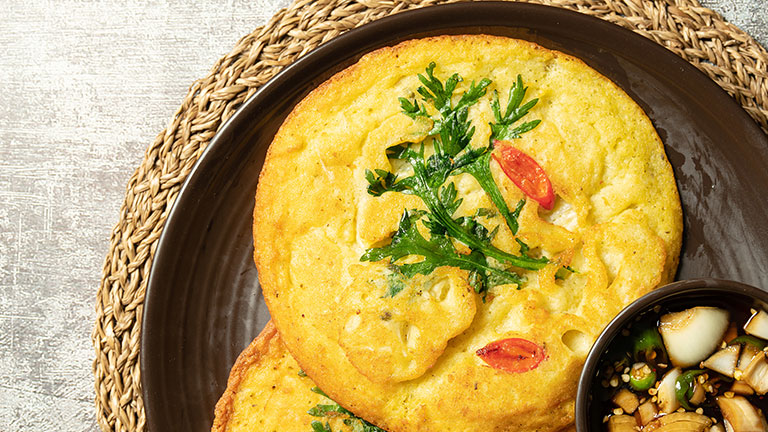
We bite into the crunchy, savory pancakes, which retain delightfully spicy notes of kimchi (pickled cabbage), and follow Hong to explore the rest of Gwangjang, which sells everything from textiles to traditional medicines.
At the market’s food section, we can’t stop marveling at mounds of fresh meats, piles of dried herbs, rows of pickled vegetables, and tanks of live fish and squid. Koreans take provisions very seriously because frigid winters, scorching summers and scarce arable land had made feeding families difficult throughout history, particularly during periods of war, one of which resulted in the Japanese occupation from 1910 to 1945.
After the Japanese withdrew and the armistice with North Korea was signed in 1953 following the Korean War, resourceful and resilient South Koreans “wanted to modernize without losing our cultural identity,” Hong adds.
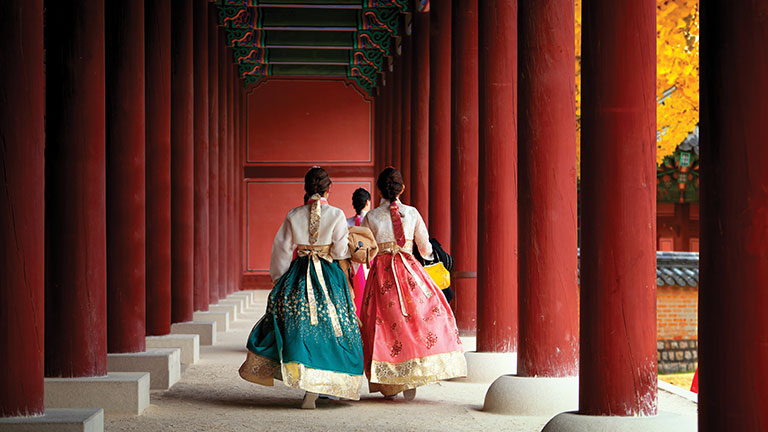
Mutual admiration
Dennis and I are in South Korea, nicknamed the Land of the Morning Calm, for a nine-day trip that includes Seoul and Busan, the country’s second largest city. Busan is home to one of the world’s biggest and busiest ports and, like Seoul, combines a 21st-century skyline with Buddhist temples.
Our willingness to put up with the 22-hour flight time from New York and the sometimes-brutal jet lag is being rewarded by an exhilarating kaleidoscope of experiences. And we aren’t the only Westerners here.
The popularity of foods like kimchi and Korean-BBQ as well as entertainment such as K-pop (particularly the band BTS) and the four-time Oscar-winning movie Parasite have put South Korea on the tourist map. Plus, Koreans’ admiration for American culture matches our wonder for theirs, making the country a magnet for US tourists.

The splendor of Seoul
Seoul, where nearly 10 million residents sprawl across 234 square miles, rivals the world’s richest metropolises while retaining its uniquely Korean character, with many store signs written only in Hangul script, the Korean alphabet. Here, ancient palaces nestle in between skyscrapers, traditional markets elbow luxury shopping malls, and old-world teahouses neighbor modern patisseries.
Although known by different names over time, Seoul has been the country’s capital for more than 600 years, with five royal palaces sprinkled throughout the city. The largest and most beautiful of them is Gyeongbokgung, once the main residence of the kings of the Joseon (also spelled Choson) dynasty that governed for more than five centuries.
We tour Gyeongbokgung with Hong, reaching the palace complex by subway. Once we arrive, we feel as if we’ve stepped back in time surrounded by so many people wearing traditional Korean clothes. Called hanbok, the attire consists of long, full, graceful skirts with short jackets for women and trousers with overcoats and hats for men. It’s both a ritual and a fashion statement to explore Seoul’s royal past dressed in vintage outfits while taking hundreds of selfies.
“Koreans love being old-fashioned and modern at the same time, so they post TikTok videos wearing hanbok,” says Hong. Just then, I spot a group of Western tourists sporting traditional garb. “Yes, you too can rent a hanbok if you’d like,” adds Hong.
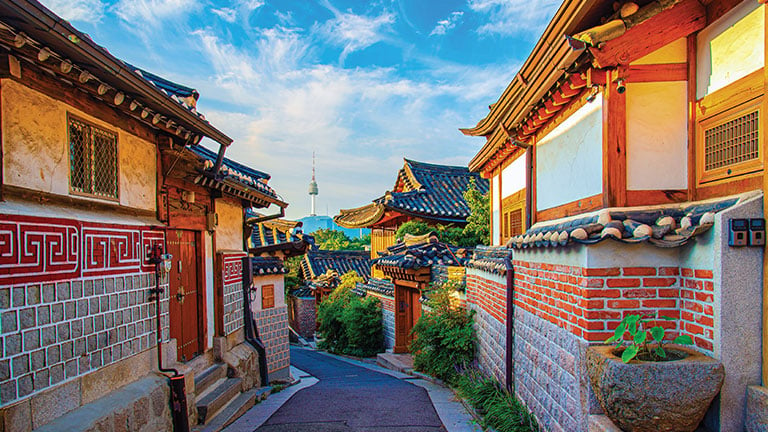
I heed the advice, emerging from a little rental shop clad in a puffy hot-pink skirt and embroidered jacket, silk flowers woven into my hair, all for the equivalent of $20. The deal proves worth it as hanbok wearers enjoy free entry to the Gyeongbokgung complex, which includes the National Palace Museum of Korea and the National Folk Museum of Korea.
The palace consists of multiple wooden structures, built in a distinctive Joseon style, with curved roofs and colorful carvings in natural materials like wood and stone, echoing the principles of symmetry, balance and harmony shared by both Confucians and Buddhists. We’re unable to enter the palace itself, though, because the historic buildings are too fragile.
Dennis and I part with Hong and switch to the local navigation apps Naver and Kakao. (Google Maps doesn’t work in Korea.) We walk about 20 minutes to Bukchon Hanok Village (a hanok is a traditional Korean-style home), where residents still live in ancestral homes built some 600 years ago. Over time, the houses were modernized, with plumbing and electricity introduced, but their clay-tile roofs and chiseled wooden doors were preserved. Many still rely on a traditional home heating system, called ondol, which consists of stone conduits built underneath the house floors that channel hot air from the kitchen fireplace, keeping the rooms warm all night long.
Our village walk culminates at the top of a hill with a panoramic view of Seoul and the beautifully tiled hanok roofs. On the way down, we dive into souvenir shops, picking out gifts—handmade pottery, silk scarves, and little bottles of berry- and ginseng-infused liqueurs. We replenish with pastries and cherry blossom tea at an elegant teahouse and later opt for an early barbeque dinner. Our meat arrives uncooked, already marinated in different spices. We cook it ourselves while sitting at a table that has a grill, enjoying it with side dishes that include kimchi, marinated veggies and rice.
The next morning, we join a tour group for a day trip from Seoul to the Demilitarized Zone, or DMZ, the closest to North Korea we’ll ever be. The trip includes a walk through one of the underground tunnels that the North Korean military dug in the 20th century in a failed attempt to launch a surprise attack on Seoul. As we walk through the tunnel wearing hardhats to protect against protruding rocks, I marvel at its width and height; it’s big enough for a small army to pass through. South Koreans, we learn, discovered the tunnels by noises and steam rising from the ground.
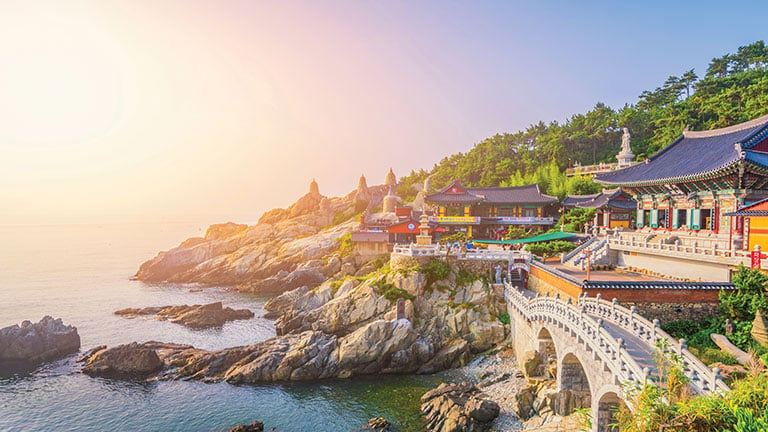
The beauty of Busan
In Busan, we arrive at Yeongdo Haenyeo Culture Exhibition Hall to learn about some of South Korea’s most famous inhabitants. Just a few hours earlier, we discover, an agile 80-year-old grandmother and several other women (called haenyeo) dove 60 feet underwater without scuba equipment, holding their breaths for up to two minutes at a time. Originally from Jeju Island off the coast of South Korea, haenyeo passed these breathing techniques from mothers to daughters for generations, a skill so unique that it earned them the nickname of sea mermaids and a UNESCO designation as an intangible cultural heritage.
As I savor today’s catch—squid, sea urchin and abalone, still redolent of the sea—at the exhibition hall’s restaurant (there’s also a museum), I’m in awe that this ancient profession still exists here in Busan, where the commercial fishing fleet unloads tons of sea bounty daily. The tradition may not survive for long. The daughters of most modern haenyeo don’t want to follow their mothers into the sea. That’s not surprising as it’s a hard and dangerous way to make a living.
Our next stop is Haedong Yonggungsa, a Buddhist temple first built in 1376 (and reconstructed in 1970), chiseled into the edge of a mountain towering above the coastline. Overlooking the ocean waves breaking below, the temple comprises several buildings connected by cliffside stairways, offering spectacular views. It takes 108 steps to walk down to the temple (and as many back up), but on the way, you may rub the bellies of various Buddhas, asking for wishes or blessings.
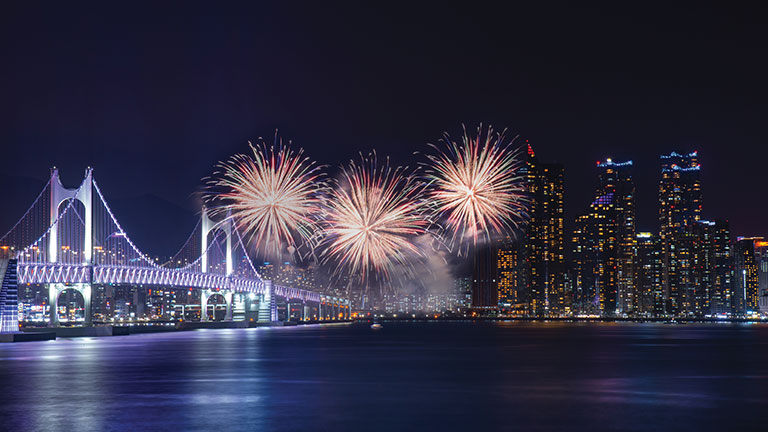
Another spectacular example of cliffside construction is the Gamcheon Culture Village, famed for its terraced, rainbow-hued homes built in a staircase fashion, literally hanging over the sea. Originally a settlement for Korean war refugees, the village evolved into a tourist attraction thanks to its vibrant street art, murals, sculptures and winding stairs that lead to charmingly secluded back alleys. Sometimes described as Busan’s Santorini, albeit infused with more color, Gamcheon is a rich cultural maze to explore, packed with souvenir shops, cafés and dessert stands selling a lighter, less creamy sort of ice cream.
As the day winds down, Dennis and I head to Busan’s port for a cruise. I anticipate a standard sail into the sunset, but instead we cruise into an extraordinary evening. As darkness descends, numerous boats venture out to sea, carrying fireworks equipment and taking turns setting the night aglow. As multicolored bursts paint the sky, we feel as if we were standing beneath a giant kaleidoscopic cupola.
The next morning, as the bullet train whisks us back to Seoul to fly home, I muse over how we came to satiate our curiosity—only to realize there’s so much more to experience in the Land of the Morning Calm. We may have seen the best of Korea, but one day, we’ll return to see the rest.
